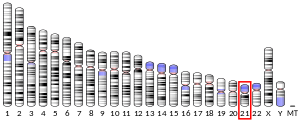MX1
Interferon-induced GTP-binding protein Mx1 is a protein that in humans is encoded by the MX1 gene.[3][4]
In mice, the interferon-inducible Mx protein is responsible for a specific antiviral state against influenza virus infection. The protein encoded by this gene is similar to the mouse protein as determined by its antigenic relatedness, induction conditions, physicochemical properties, and amino acid analysis. This cytoplasmic protein is a member of both the dynamin family and the family of large GTPases.[4]
References
- GRCh38: Ensembl release 89: ENSG00000157601 - Ensembl, May 2017
- "Human PubMed Reference:". National Center for Biotechnology Information, U.S. National Library of Medicine.
- Haller O, Staeheli P, Kochs G (Jul 2007). "Interferon-induced Mx proteins in antiviral host defense". Biochimie. 89 (6–7): 812–8. doi:10.1016/j.biochi.2007.04.015. PMID 17570575.
- "Entrez Gene: MX1 myxovirus (influenza virus) resistance 1, interferon-inducible protein p78 (mouse)".
Further reading
- Pavlovic J, Haller O, Staeheli P (1992). "Human and mouse Mx proteins inhibit different steps of the influenza virus multiplication cycle". J. Virol. 66 (4): 2564–9. PMC 289059. PMID 1548781.
- Horisberger MA (1992). "Interferon-induced human protein MxA is a GTPase which binds transiently to cellular proteins". J. Virol. 66 (8): 4705–9. PMC 241296. PMID 1629950.
- Petersen MB, Slaugenhaupt SA, Lewis JG, et al. (1991). "A genetic linkage map of 27 markers on human chromosome 21". Genomics. 9 (3): 407–19. doi:10.1016/0888-7543(91)90406-5. PMID 1674496.
- Horisberger MA, McMaster GK, Zeller H, et al. (1990). "Cloning and sequence analyses of cDNAs for interferon- and virus-induced human Mx proteins reveal that they contain putative guanine nucleotide-binding sites: functional study of the corresponding gene promoter". J. Virol. 64 (3): 1171–81. PMC 249231. PMID 2154602.
- Pavlovic J, Zürcher T, Haller O, Staeheli P (1990). "Resistance to influenza virus and vesicular stomatitis virus conferred by expression of human MxA protein". J. Virol. 64 (7): 3370–5. PMC 249583. PMID 2161946.
- Aebi M, Fäh J, Hurt N, et al. (1990). "cDNA structures and regulation of two interferon-induced human Mx proteins". Mol. Cell. Biol. 9 (11): 5062–72. PMC 363658. PMID 2481229.
- Weitz G, Bekisz J, Zoon K, Arnheiter H (1990). "Purification and characterization of a human Mx protein". J. Interferon Res. 9 (6): 679–89. doi:10.1089/jir.1989.9.679. PMID 2607176.
- Maruyama K, Sugano S (1994). "Oligo-capping: a simple method to replace the cap structure of eukaryotic mRNAs with oligoribonucleotides". Gene. 138 (1–2): 171–4. doi:10.1016/0378-1119(94)90802-8. PMID 8125298.
- Melén K, Keskinen P, Ronni T, et al. (1996). "Human MxB protein, an interferon-alpha-inducible GTPase, contains a nuclear targeting signal and is localized in the heterochromatin region beneath the nuclear envelope". J. Biol. Chem. 271 (38): 23478–86. doi:10.1074/jbc.271.38.23478. PMID 8798556.
- Ponten A, Sick C, Weeber M, et al. (1997). "Dominant-negative mutants of human MxA protein: domains in the carboxy-terminal moiety are important for oligomerization and antiviral activity". J. Virol. 71 (4): 2591–9. PMC 191379. PMID 9060610.
- Fernández M, Quiroga JA, Martín J, et al. (1997). "Impaired interferon induction of human MxA protein in chronic hepatitis B virus infection". J. Med. Virol. 51 (4): 332–7. doi:10.1002/(SICI)1096-9071(199704)51:4<332::AID-JMV12>3.0.CO;2-K. PMID 9093949.
- Suzuki Y, Yoshitomo-Nakagawa K, Maruyama K, et al. (1997). "Construction and characterization of a full length-enriched and a 5'-end-enriched cDNA library". Gene. 200 (1–2): 149–56. doi:10.1016/S0378-1119(97)00411-3. PMID 9373149.
- Li Y, Youssoufian H (1998). "MxA overexpression reveals a common genetic link in four Fanconi anemia complementation groups". J. Clin. Invest. 100 (11): 2873–80. doi:10.1172/JCI119836. PMC 508494. PMID 9389754.
- Kochs G, Trost M, Janzen C, Haller O (1998). "MxA GTPase: oligomerization and GTP-dependent interaction with viral RNP target structures". Methods. 15 (3): 255–63. doi:10.1006/meth.1998.0629. PMID 9735310.
- Weber F, Haller O, Kochs G (2000). "MxA GTPase blocks reporter gene expression of reconstituted Thogoto virus ribonucleoprotein complexes". J. Virol. 74 (1): 560–3. doi:10.1128/JVI.74.1.560-563.2000. PMC 111572. PMID 10590150.
- Hattori M, Fujiyama A, Taylor TD, et al. (2000). "The DNA sequence of human chromosome 21". Nature. 405 (6784): 311–9. doi:10.1038/35012518. PMID 10830953.
- Hijikata M, Ohta Y, Mishiro S (2000). "Identification of a single nucleotide polymorphism in the MxA gene promoter (G/T at nt -88) correlated with the response of hepatitis C patients to interferon". Intervirology. 43 (2): 124–7. doi:10.1159/000025035. PMID 10971132.
- Engelhardt OG, Ullrich E, Kochs G, Haller O (2002). "Interferon-induced antiviral Mx1 GTPase is associated with components of the SUMO-1 system and promyelocytic leukemia protein nuclear bodies". Exp. Cell Res. 271 (2): 286–95. doi:10.1006/excr.2001.5380. PMID 11716541.
- Hijikata M, Mishiro S, Miyamoto C, et al. (2002). "Genetic polymorphism of the MxA gene promoter and interferon responsiveness of hepatitis C patients: revisited by analyzing two SNP sites (-123 and -88) in vivo and in vitro". Intervirology. 44 (6): 379–82. doi:10.1159/000050075. PMID 11805446.
- Kochs G, Haener M, Aebi U, Haller O (2002). "Self-assembly of human MxA GTPase into highly ordered dynamin-like oligomers". J. Biol. Chem. 277 (16): 14172–6. doi:10.1074/jbc.M200244200. PMID 11847228.
This article is issued from Wikipedia. The text is licensed under Creative Commons - Attribution - Sharealike. Additional terms may apply for the media files.


